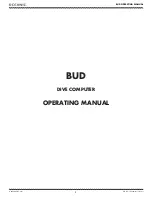
6BChapter Three: Overview
65BFault Conditions
41
Fault Conditions
Your device can detect two general types of fault conditions (Table 16, page 41):
•
Minor (recoverable and unrecoverable)
•
Major (unrecoverable)
Fault conditions are indicated by the Module Status LED and through the Exception Status,
Exception Alarm Detail, and Exception Warning Detail attributes in the S-Device Supervisor
Object. (Refer to
S-Device Supervisor Object,
page 72
,
for more information.)
Minor Faults
Minor faults occur when:
•
Pressure is too high (> 105%FS) or too low (< -5% FS).
•
Calibration has expired.
•
Analog input value is out of range.
Minor faults are indicated in Table 47, page 79.
Major Faults
A major unrecoverable fault occurs when a hardware problem with the EEPROM or a memory
problem with the RAM is detected during the initial diagnostic check.
When this fault condition occurs, the Module Status LED illuminates
solid red,
in accordance
with the ODVA “DeviceNet Specification,” Volume I [1].
Note
When a major unrecoverable fault occurs, the device cannot communicate on the
network and operation stops. Contact MKS for assistance.
Table 16: Fault Conditions
Fault Type
Module Status
LED State
Description
Minor Recoverable
Fault
Solid / Flashing*
Green
Device remains in the Operating state.
The specific cause of the fault is reported in the
exception status bit.
Minor Unrecoverable
Fault
Solid /
Flashing* Green
Device remains in the Operating state
.
The specific cause of the fault is reported in the
exception detail alarm status bit.
Major Unrecoverable
Fault
Solid Red
Device transitions to the Critical Fault state.
The device will not respond to any services
received over the network. All reporting
associated with Publication objects are disabled.
* The Module Status LED flashes when the visual indicator is on. Refer to Table 47, page 79,
for more information.
Artisan Technology Group - Quality Instrumentation ... Guaranteed | (888) 88-SOURCE | www.artisantg.com
















































